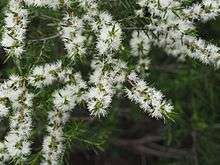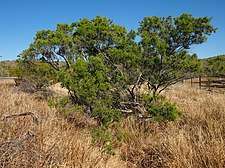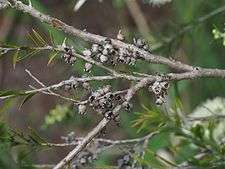Melaleuca bracteata
Melaleuca bracteata, commonly known as the black tea-tree, river tea-tree or mock olive is a plant in the myrtle family, Myrtaceae and is endemic to northern Australia. It usually occurs as a large shrub but under ideal conditions can grow into a tree up to 10 m (30 ft) tall. It is an adaptable species in cultivation and a number of cultivars have been developed.
| Black tea-tree | |
|---|---|
 | |
| Melaleuca bracteata leaves and flowers | |
| Scientific classification | |
| Kingdom: | Plantae |
| Clade: | Tracheophytes |
| Clade: | Angiosperms |
| Clade: | Eudicots |
| Clade: | Rosids |
| Order: | Myrtales |
| Family: | Myrtaceae |
| Genus: | Melaleuca |
| Species: | M. bracteata |
| Binomial name | |
| Melaleuca bracteata | |
 | |
| Occurrence data from AVH 14 March 2020 | |
Description
Melaleuca bracteata is a bushy-foliaged, small to medium tree, normally 5–8 m (20–30 ft) tall but occasionally taller and it usually flowers and sets seed by the time it is 5–8 m (20–30 ft) tall. Its bark is rough and dark grey in colour. The leaves are narrow, lance-shaped to linear, 8–28 mm (0.3–1 in) long by 1–3 mm (0.04–0.1 in) wide with no stalk, or a very short stalk. The leaves are spirally arranged around the stem and crowded together. The upper surface of the leaf is hairy, especially when young, with many oil-dots.[1][2][3]
The black tea-tree flowers profusely. Flowers are loosely arranged in clusters to form cylindrical or ovoid spikes, 30–90 mm (1–4 in) long by about 15 mm (0.6 in) across, coloured cream or white. Each flower usually has a leaf at its base and the petals are shed soon after the flower opens. Flowering occurs from spring to early summer and is followed by fruit which are more or less spherical to oval or barrel-shaped, about 3 mm (0.1 in) in diameter, sparsely arranged along the branches.[1][2][3]


Taxonomy and naming
Melaleuca bracteata was first described in 1858 by Ferdinand von Mueller in Fragmenta phytographiae Australiae from a specimen collected near Moreton Bay in Queensland.[4][5] The specific epithet (bracteata) is derived from the Latin word bractea, meaning "bract".[3]
Distribution and habitat
Black tea-tree occurs in Western Australia, the Northern Territory, and from north-east Queensland southwards to the Macleay River in New South Wales. It grows near the coast and inland, along stream banks and in wet sites.[1][2] In New South Wales it has been recorded on the Northern Tablelands, North Coast and North West Slopes biogeographic regions.[6] In Western Australia it occurs in the Kimberley and in the Carnarvon and Pilbara biogeographic regions.[7] There are also disjunct populations in South Australia.[8]
Conservation status
This species is classified as "not threatened" in Western Australia by the Government of Western Australia Department of Parks and Wildlife.[9]
Uses
Horticulture
M. bracteata is a useful tree in cultivation because it will grow almost anywhere and because of its compact shape and many flowers.[2] Garden cultivars that have been developed include "Revolution Gold", "Revolution Green" and a dwarf form called "Golden Gem".[1]
Indigenous use
It has been used in smoking medicine in the Northern Territory and for making numerous household items.[10][11]
Gallery
 Melaleuca bracteata at the extreme southern end of its distribution
Melaleuca bracteata at the extreme southern end of its distribution- Cultivar "Revolution Gold" in Kunming Botanical Garden
 Trunk of M. bractata growing in California.
Trunk of M. bractata growing in California.
References
- Holliday, Ivan (2004). Melaleucas : a field and garden guide (2nd ed.). Frenchs Forest, N.S.W.: Reed New Holland Publishers. pp. 30–31. ISBN 1876334983.
- "Melaleuca bracteata". Australian Tropical Rainforest Plants. CSIRO. Retrieved 1 March 2015.
- Brophy, Joseph J.; Craven, Lyndley A.; Doran, John C. (2013). Melaleucas : their botany, essential oils and uses. Canberra: Australian Centre for International Agricultural Research. pp. 94–95. ISBN 9781922137517.
- "Melaleuca bracteata". APNI. Retrieved 1 March 2015.
- von Mueller, Ferdinand. "Fragmenta Phytographiae Australiae". Retrieved 1 March 2015.
- Wilson, Peter G. "Melaleuca bracteata". PlantNET. Retrieved 1 March 2015.
- Paczkowska, Grazyna; Chapman, Alex R. (2000). The Western Australian flora : a descriptive catalogue. Perth: Wildflower Society of Western Australia. p. 392. ISBN 0646402439.
- Carrick, John; Chornley, K. (1979). "A review of Melaleuca L. (Myrtaceae) in South Australia" (PDF). Journal of the Adelaide Botanic Gardens. 1 (5): 314. Archived from the original (PDF) on 24 September 2015. Retrieved 1 March 2015.
- "Melaleuca bracteata". FloraBase. Western Australian Government Department of Parks and Wildlife.
- Latz, Peter Jenny; Green, Jenny (illustrations) (1996). Bushfires & bushtucker : Aboriginal plant use in Central Australia. Alice Springs, N.T.: IAD Press. ISBN 0949659967.
- Williams, Cheryll (2010). Medicinal plants in Australia (1. ed.). Dural, N.S.W.: Rosenberg. p. 301. ISBN 9781877058943. Retrieved 2 March 2015.
- Marcar, Nico E.; Crawford, Debbie F. (1995). Trees for saltland : a guide to selecting native species for Australia. [Canberra]: CSIRO Division of Forestry. p. 65. ISBN 0643058192.
| Wikimedia Commons has media related to Melaleuca bracteata. |